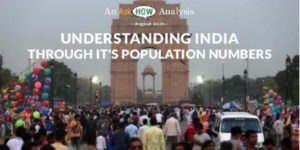Geography and demography: China through an Indian lensfeatured
I got a WhatsApp forward that said that the rail density in India was more than that in China. Now, we all know about China’s world class infrastructure and its astonishing high-speed trains. The WhatsApp forward seemed to contradict my understanding of Chinese infrastructure. The seeming contradiction was resolved only when I remembered the Hu line: a concept that is critical to understanding the demography and geography of China. This post explores these topics. Let us begin some basic facts.

We know that China and India are the two most populous countries in the world. At 1.4 billion, the population of each country is more than that of any continent (other than Asia). We also know that China is much bigger than India. At 9.6 million square kilometers, its area is nearly 3 times that of India. The density of population of China is much lower than that of India. However, the average density does not tell the full story and this is where the Hu Line comes in.
What is the Hu line and why is it important? In 1935, a cartographer named Hu Huanyong, drew a line on the map of China. It divides China into two parts with very different population densities. The line stretches from the city of Heihein in the northeast to Tengchong in south, diagonally across the country. The land on the east of Hu line, is flatter and wetter. The west has deserts, mountains and dry plateaus and is very sparsely populated. According to BigThink, this is how the two sides looked in 2015
· West of the line, 6 percent of the population on 57 percent of the territory (average population density: 39.6 inhabitants per square mile (15.3/km2).
· East of the line, 94 percent of the population on 43 percent of the territory (average population density: 815.3 inhabitants per square mile (314.8/km2).
India also has more dense and less dense parts. The Ganga basin states — Uttar Pradesh, Bihar and West Bengal — are densely populated. In 2011, the density in Bihar and West Bengal was more than a 1,000 people per square kilometer and that in UP more than 800 people per square kilometer. In contrast, places such as the desert in Rajasthan, the forests of central India and the Himalayas in North are sparsely populated. However, our population distribution is not as uneven as it is in China. For example, the density of populationin Tamil Nadu and Kerala, far away from Ganga, was 555 and 860 respectively in 2011.
As I have explained in detail, the density of population in any region is function of how much agricultural land is there to support the population and India has the highest amount of arable land in the world. China has less arable land than India and almost all of it is on the East side of Hu Line.
So, what has the Hu line got to do with train density? Most of infrastructure of China is concentrated in the East of the country. The land West of the Hu line is so sparsely populated that it cannot support a dense rail network. For example, there can only be a few trunk lines to and from Tibet. Most of the vast plateau would be connected only by roads and not trains. This is a significant factor in making the overall density of railways in China lower than that in India*.
The difference in variability in density of population is not the only big difference in Chinese and Indian demographics. India’s population is expected to grow till 2065, whereas China’s population actually shrank this year. This change was long coming. The fertility rates (number of children a woman is expected to have) in both countries has been falling for decades. However, the fall in China was dramatic starting around 1970 as this chart from World Bank shows.

China introduced many population control measures in the 1970s. These included raising the age of marriage, encouraging couples to wait longer to have children and to have a longer gap between children. In 1979 the country introduced the draconian one child policy, which was written in the constitution in 1982. Couples were required, by law, to have a maximum one child. The policy was enforced with instruments such as fines and compulsory measures such as Inter Uterine Devices and even sterilization. Over a period of time, exceptions were introduced in the policy. For example, rural couples were allowed to have a second child if their first one was a girl. Ethnic minorities were exempted from these restrictions. Due to these exceptions, the policy was sometimes referred to as 1.5 child policy.
There is a vigorous debate amongst scholars about how much of the reduction in fertility is due to government policies and how much of it would have happened anyway with prosperity and urbanization. There is no doubt however, that the dramatic reduction in fertility has had many consequences.
The fall in fertility in China was preceded by a boom in child birth which itself came after a famine. The famine killed many of the older people and the boom led to many children. This exaggerated the demographic dividend effect. For many decades, the ratio of working age population to the dependent population was very high in China. Economics and development are complex and multifactor, but there is no doubting that this demographic effect was a contributor to China’s prosperity. The converse of the demographic dividend is now happening in China. As Arthur R. Kroeber says in the excellent book ‘China’s Economy’
“In 2020, a bit less than one in five Chinese is over 60; that figure will rise to one in four by 2030, and one in three by 2050. …By 2035, there will be just over three workers per retiree, about the same as Unites States today. And by 2050 there will be only two — about the same figure as present-day Japan. “
The strict implementation of population control measures in the country had many social consequences. Couples were strongly encouraged to choose between Inter Uterine Device for the woman or vasectomy for the man. Population control measures also undoubtedly led to practices like sex selective abortion as there is a cultural preference for the male child. Couples attempting to evade population control measures engaged in all kinds of practices ranging from abandoning girl children to birth tourism. One very curious social consequence was pointed out to me by a friend of mine — There are many people in China who not only not have a sibling but also don’t have first cousins!
In 2013, China announced some relaxations to the One Child policy for urban residents. In 2015, all couples could have two children. The policy was finally ended in 2021 but it is not clear how much the fertility would rise now.
The geography and demographic history of China are very complex. I have condensed it a lot — each sentence can be expanded to multiple novels and doctorate theses. I encourage readers to go to primary sources for more. Demographics of India is also very complex and consequential. I would encourage readers to got to our detailed piece and my blog posts on this topic. What is not in doubt is that it is impossible to even begin to understand the two countries without appreciating the basics of geography and demographics.
*Readers have pointed out that there are other factors that could make the Chinese rail density lower than that of India. For example history (including impact of freight equalisation scheme), use of water ways (Shankar) and higher speed of trains in China (Abhijit). My original text read as if I think that the density of population is the only reason. That is not so and I have edited this post accordingly.
I am trying to understand China better and this is my second article on India and China comparisons. I will keep posting what I learn in this list — Viewing China through an Indian lens.
If you wish to stay in touch with my writing, follow me on medium. Click on the envelope icon to get your stories delivered in your Inbox.
You can follow AskHow India (@AskHowIndia) or me (@YogeshUpadh) on twitter or on LinkedIn
Telegram channel: t.me/YogeshUpadhyaya
Author –
Yogesh Upadhyaya
(Yogesh Upadhyaya is one of the founders of AskHow India. Blogs are personal views.)



